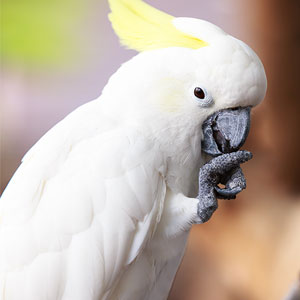
Trimming Your Bird's Nails
Pet birds spend a majority of their time on their feet, especially if their wings are clipped. A pedicure for your bird is as necessary for your bird as it is beneficial for you. If your bird has long nails, they can get caught on things and make perching difficult. Nails can also break or tear if they get caught and may start bleeding. Trimming nails should be done regularly to prevent problems such as these. If your bird's toe is elevated off the ground when his feet are put on a level surface, it is probably time to trim his nails.
If you plan on doing the trimming yourself, there are some steps that can make the process easier. First, it is very helpful if your bird is comfortable with having his feet touched. You can encourage this through play, like a high five. The next step is to let your bird become comfortable with the clippers or file. Let him examine it and maybe bite on the handle. You might also cut one of your fingernails with it before you try to trim his.
Items Needed
- Styptic powder (Kwik Stop®) - to stop any bleeding that may occur while cutting nails.
- Bird or guillotine-style (used on cats) nail clippers – to easily cut your bird's nails. Instead of a clipper, you can also use a nail grinder to grind your bird's nails down.
Trimming Steps
- In order to clip your bird's nails, restrain him in a towel so he doesn't hurt himself while you are clipping. Sometimes people like to do one nail a day while they are playing with their bird, and he doesn't even notice.
- Once you're ready to clip the nail, watch out for the blood vessel (quick) in your bird's nail. If your bird has light-colored nails, try to identify where the nail meets the quick. The quick will be pink. If the nails are dark, be cautious and trim just a little at a time. Clip only the pointed ends off of each nail. If you cut the nail too short, you could cut the quick and the nail will start bleeding. Also, you don't want to cut the nail so short that your bird can't properly grip.
- If the nail does start bleeding, apply styptic powder or a gel/liquid cautery agent to stop the bleeding. Watch your bird for any new bleeding.
Other Tips
If a bird's nails grow too long, the quick will also grow out. This makes trimming the nails very difficult and often painful. In this situation, it is better to trim the nails back a little bit at a time. This will encourage the quicks to recede, as well.Rough surface perches work well for keeping the nail length down, and it allows your bird to trim his own nails. The Calcium Perch, Beach Sands Perch, and Sand Walk Orthopedic Perch all have a rough texture to effectively groom and trim nails. Using rough and textured perches also means that you won't have to clip your bird's toenails as frequently. After installing a new perch in your bird's cage, make sure to check the bottom of his feet to ensure that it isn't too rough on his feet.
One of the best things for your bird's foot health is routine grooming and trimming to keep his nails the proper length. If you have any doubts or questions concerning your bird's nails, have a professional trim the nails or show you how.
Discover More!
How to Trim Bird Nails (Video)My First Bird: How Do I Care For My New Bird?
Clipping Your Bird's Wings
Return to Bird Articles


